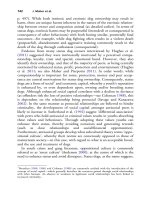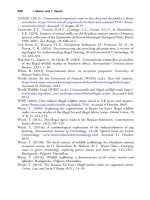The palgrave international handbook of a 255
Bạn đang xem bản rút gọn của tài liệu. Xem và tải ngay bản đầy đủ của tài liệu tại đây (24.87 KB, 1 trang )
Animal Abuse Resulting from Wildlife Habitat Destruction
251
only human intervention that can lead to change (for example, the spread of
invasive species can transform local ecologies—although this, too, can be caused
by human interventions directly [by purposefully transferring species] or indirectly [through human-caused climate changes that induce migration of species]).
Many environmental harms can be characterised as natural resource crimes
(for example, illegal trafficking of wildlife, illegal logging and illegal fishing)
or pollution crimes (for example, illegal movement and disposal of hazardous
wastes). Even when legal, such activities can nonetheless be harmful, even if
subject to regulation and permit conditions. Certain activities, such as both
legal and illegal land grabs for the purpose of transforming forests into
monoculture ‘flex crops’ (crops that can be used for food, feed, fuel or
industrial material), also cause considerable environmental harm (pollution,
land degradation and contribution to carbon emissions). All of these, in turn,
can be linked to wider ecological threats to the planetary environment and, in
the present context, threats to specific nonhuman animal species.
According to the United Nations there are five principle threats to
biodiversity (United Nations Environment Programme 2013). These are:
1. the unsustainable harvesting of natural resources, including plants, animals and marine species;
2. the loss, degradation or fragmentation of ecosystems through land conversion for agriculture, forest clearing, etc.;
3. invasive non-native or ‘alien’ species being introduced to ecosystems to
which they are not adapted, i.e. where they have no, or not enough,
predators to maintain an ecological balance;
4. pollution; and
5. climate change.
There are complex reasons why these threats emerge as they do, and they are
interlinked in a variety of ways. Reduction in species includes both animals
and plants. This is significant insofar as complex ecosystems depend upon the
interaction between all species, and any change will impact upon overall
functioning. This is particularly apparent with respect to forest ecosystems.
About 13 % of the world’s total forest area is under formal protection and
almost 75 % is covered by national forest programs. Yet, despite progress in
the regulatory sphere and net gains in forest areas in Europe and Asia, total
loss of forest cover during the last decade still averaged around 13 million
hectares per year. Most deforestation is occurring in tropical forests, many
located in Asian countries such as Indonesia, Malaysia, Thailand and
Myanmar, with substantial biodiversity impacts:









